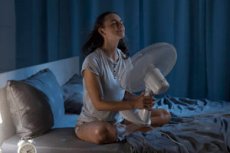
亥姆霍兹慕尼黑中心和奥格斯堡大学医院的研究人员最近开展了一项由亚历山德拉·施耐德博士领导的研究,结果表明,夜间高温会显著增加中风风险。这些发现有助于制定预防措施,帮助人们更好地抵御气候变化和日益频繁的高温夜晚带来的风险。此外,了解高温夜晚的影响可以改善患者护理。
“我们想了解夜间高温对健康的危害程度,”亥姆霍兹慕尼黑环境风险研究工作组负责人说道。“这很重要,因为气候变化导致夜间气温上升速度远快于白天。”
15 年来 11,000 例中风的数据
在发表于《欧洲心脏杂志》的研究中,研究人员分析了奥格斯堡大学医院的数据。该院神经内科收集了15年来约1.1万例中风病例的数据。分析显示,夜间极端高温会使中风风险增加7%。
“老年人和女性尤其容易受到感染,在炎热的夜晚后,医院诊断出的中风大多是轻度中风,”主要作者何成博士说。“我们的研究结果清楚地表明,调整城市规划和医疗保健对于降低夜间气温升高带来的风险至关重要。”
“我们能够证明,与2006年至2012年相比,2013年至2020年期间与高温夜间相关的中风风险显著增加,”奥格斯堡大学医院中风科和神经血管研究工作组主任迈克尔·埃尔教授强调道。2006年至2012年,在研究区域,高温夜晚每年导致两例新增中风病例;2013年至2020年,每年记录新增33例。
适应战略和城市规划的建议
研究人员计划将他们的研究成果应用于实际环境。为此,他们正在为公众和城市规划提供适应策略建议,例如降低城市热岛效应的强度。目标是更好地保护民众免受夜间高温的影响。
这项研究还将为进一步研究制定针对中风诱因的针对性预防措施奠定基础。“这些预防措施越早实施越好,”施耐德说道。
这项研究的结果对医院也具有重要意义。它们将能够更好地应对未来中风的发病率:如果天气预报预测夜晚炎热,医院就可以预计会有更多中风患者入院。奥格斯堡大学神经病学医院院长马库斯·瑙曼教授解释说,这使得医院能够提前规划增加医护人员。
背景:什么是热带夜晚?
“热带夜晚”的定义采用了所谓的“热夜超标指数”(HNE)。该指数衡量夜间温度超过某个阈值的程度。该阈值是指在整个研究期间,仅有5%的最热夜晚的温度超过该阈值。
在本研究中,该值为14.6°C。如果夜间温度超过该值,则被归类为热带夜晚。HNE指数将夜间温度超过该阈值的度数相加,以确定热量强度。

